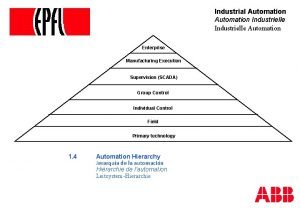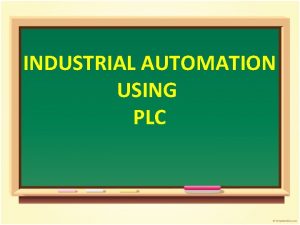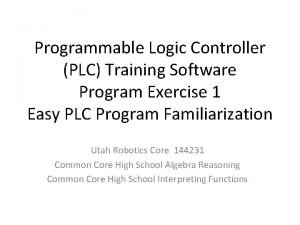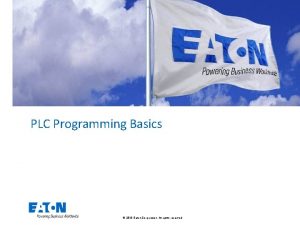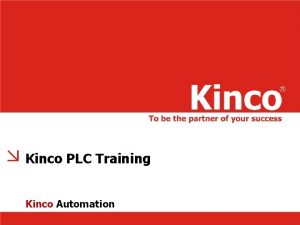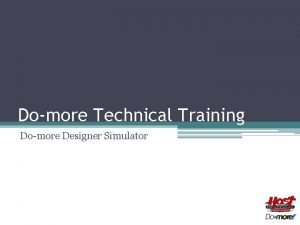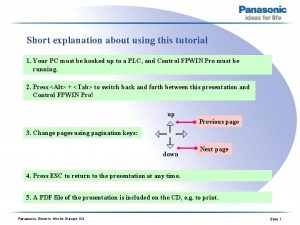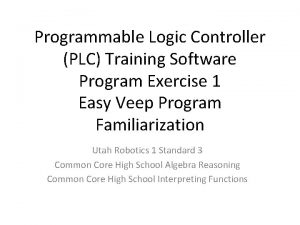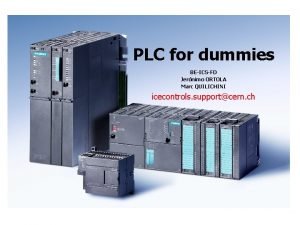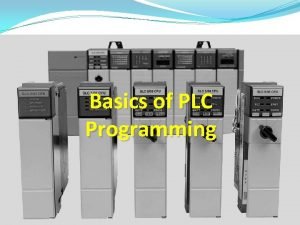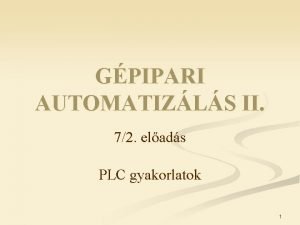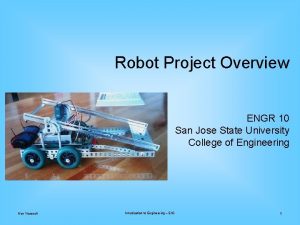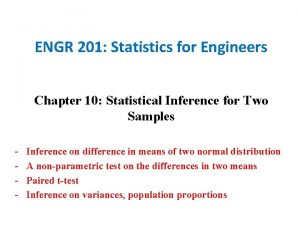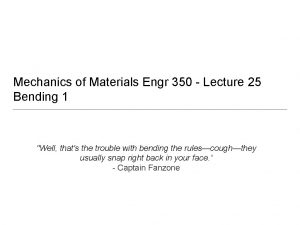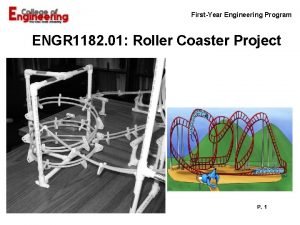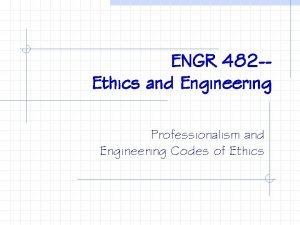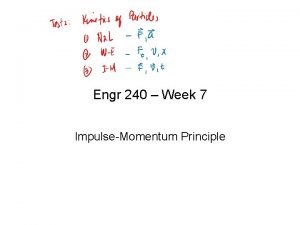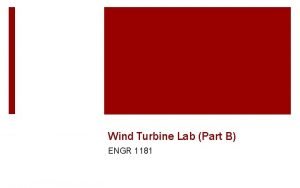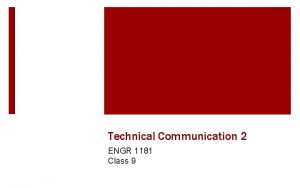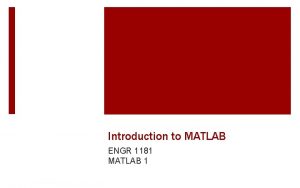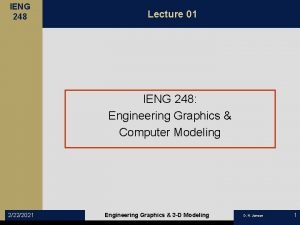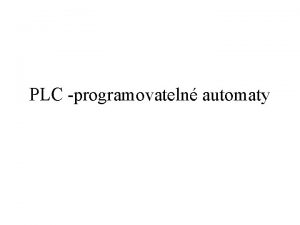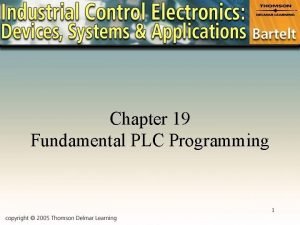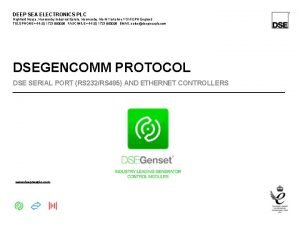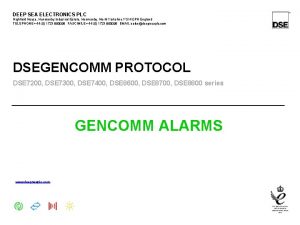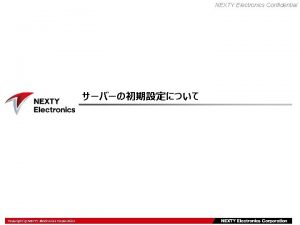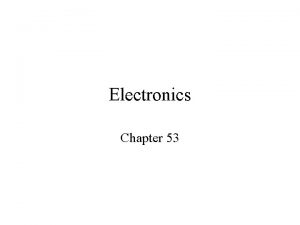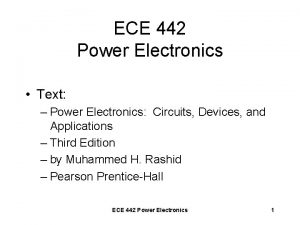PLC Programming ECE 105 Industrial Electronics Engr Jeffrey



















































- Slides: 51

PLC Programming ECE 105 Industrial Electronics Engr. Jeffrey T. Dellosa College of Engineering and Information Technology Caraga State University Ampayon, Butuan City

�The Structure and Features of Programmable Logic Controller (PLC) PLC Programming

�PLC operates by examining the input signals from a process and carrying out logic instructions (which have been programmed into its memory) on these input signals, producing output signals to drive process equipment or machinery. �Standard interfaces built-in to PLC allow them to be directly connected to process actuators and transducers without the need for intermediate circuitry or relays. PLC Programming

� Although PLCs are similar to 'conventional' computers in term of hardware technology, they have specific features suited for industrial control: ◦ Rugged, noise immune equipment; ◦ Modular plug-in construction, allowing easy replacement or addition of units (e. g. input/output); ◦ Standard input/output connections and signal levels; ◦ Easily understood programming language; ◦ Ease of programming and reprogramming in-plant; ◦ Capable of communicating with other PLCs, computers and intelligent devices; ◦ Competitive in both cost and space occupied with relay and solid-state logic systems; � These features make programmable controllers highly desirable in a wide variety of industrial-plant and process-control situations. PLC Programming

� PLC in comparison with other control systems ◦ Relay Control System -- By connecting the input and output contacts in series and/or parallel, any desired logic functions may be produced. Combinations of various logic elements may be used to create fairly complex control plans. ◦ For a simple task, the number of control relays required could be so numerous that it can result in a large control panel. ◦ A typical relay system may consist of several hundred or thousand switching contacts, which presents the design engineer with a considerable task. It is also extremely difficult to change the control function of a panel once it has been wired up, and is likely to involve a complete re-wiring of the system. PLC Programming

� PLC in comparison with other control systems ◦ Together with the other disadvantages of cost, speed and reliability, the above drawbacks for relay control system have led to the replacement of relay control systems by modern alternatives based on electronics and microprocessors. ◦ Relay continues to be used extensively as output devices (actuators) on other types of control system, being ideal for the conversion of small control signals to highercurrent/higher-voltage driving signals. PLC Programming

� The following table provides a general comparison between the control systems in terms of the capabilities. Characteristic Relay systems Digital Logic PLC systems Price per function Fairly low Low Physical size Bulky Very compact Operating speed Slow Very fast Fast Electrical noise immunity Excellent Good Time-consuming to design and install Design & test fine tuning time-consuming Simple to program & install No Yes Very difficult Difficult Very simple Poorlarge number of contacts Poor (if ICs soldered) Goodfew standard cards Installation Capable of complicated operations Ease of changing functions Ease of maintenance PLCs emerge from the comparison as the better overall choice for a control system. If the ultimate in operating speed or resistance to electrical noise is required, hardwired digital logic and relays are chosen respectively.

� PLC – Hardware ◦ PLCs are purpose-built computers consisting of three functional areas: processing, memory and input/output. ◦ Input conditions to the PLC are sensed and then stored in memory, where the PLC performs the programmed logic instructions on these input states. ◦ Output conditions are then generated to drive associated equipment. The action taken depends totally on the control program held in memory. PLC Programming

� PLC – Hardware ◦ Central Processing Unit (CPU) ◦ The CPU controls and supervises all operations within the PLC, carrying out programmed instructions stored in the memory. An internal communications highway, or bus system, carries information to and from the CPU, memory and I/O units, under control of the CPU.

�PLC – Hardware ◦ Memory ◦ All PLCs contain both RAM and ROM in varying amounts depending upon the design of the PLC. The use of a PLC's memory is determined again by the design of the unit. However, all PLC memories can be subdivided into at least five major areas. A typical memory utilization map for a PLC is depicted in the following figure. PLC Programming

�PLC – Hardware: Memory ◦ Executive Memory �The operating system or executive memory for the PLC is always in ROM since, once programmed and developed by the manufacturer, it rarely needs changing. It is the one that actually does the scanning in a PLC. �The operating system is a special machine language program that runs the PLC. It instructs the microprocessor to read each user instruction, helps the microprocessor to interpret user programmed symbols and instructions, keeps track of all the I/O status, and is responsible for maintaining/monitoring the current status of the health of the system and all its components. PLC Programming

� PLC – Hardware: Memory ◦ System memory �In order for the operating system to function, a section of the memory is allotted for system administration. As the executive program performs its duties, it often requires a place to store intermediate results and information. �A section of RAM is installed for this purpose. Normally this area is allotted for use of the operating system only and is not available to the user for programming. It might be thought of as a scratch pad for the operating system to doodle on as necessary. �Some PLCs use this area for storing the information which passes between programmer and operating system, e. g. the operating system generates certain error codes store in the specific address in this area during the execution of user program which can be read by user program; or the user may also give additional information to the operating system before execution of user program by writing some codes in the specific address in this area, etc. PLC Programming

�PLC – Hardware: Memory ◦ I/O Status Memory (I/O Image Table) �Another portion of RAM is allocated for the storage of current I/O status. Every single input/output module has been assigned to it a particular location within the input/output image table. �The location within the input and output image tables are identified by addresses, each location has its own unique address. �During the execution of user program, the microprocessor scans the user program and interpret the user commands, the status of input modules used are read from the input image table (not directly from the input module itself). Various output device status generated during the execution of user program are stored in the output image table (not directly to output modules). PLC Programming

�PLC – Hardware: Memory ◦ Data Memory �Whenever timers, counters, mathematics and process parameters are required, an area of memory must be set aside for data storage. �The data storage portion of memory is allocated for the storage of such items as timers or counter preset/accumulated values, mathematics instruction data and results, and other miscellaneous data and information which will be used by any data manipulation functions in the user program. �Some manufacturers subdivide the data memory area into two sub-memories, one for fixed data and other for variable data. The fixed data portion can only be programmed via the programming device. The CPU is not permitted to place data values in this area. The variable portion of the data memory is available to the CPU for data storage. PLC Programming

� PLC – Hardware: Memory ◦ User Program Memory �The final area of memory in a PLC is allocated to the storage of the user program. �It is this memory area that the executive program instructs the microprocessor to examine or 'scan' to find the user instructions. �The user program area may be subdivided if the CPU allocates a portion of this memory area for the storage of ASCII messages, subroutine programs, or other special programming functions or routines. In the majority PLCs, the internal data storage and user program areas are located in RAM. �Several systems do offer an option that places both the user program and the fixed data storage areas in EPROM type memory. The user can develop program in RAM and run the system to ensure correct operation. Once the user is satisfied that the programming is correct, a set of EPROMs is then duplicated from the RAM. Then the user can shut down the CPU and replaces the RAM with the newly programmed EPROM. Any future change would require that the EPROMs be reprogrammed. PLC Programming

� Input/output Module Units ◦ The input/output unit of PLCs handles the job of interfacing high power industrial devices to the low-power electronic circuitry that stores and executes the control program. ◦ Most PLCs operate internally at between 5 and 15 V DC (common TTL and CMOS voltages), whilst signal from input devices can be much greater, typically 24 V DC to 240 V AC at several amperes. ◦ The I/O module units form the interface between the microelectronics of the programmable controller and the real world outside, and must therefore provide all necessary signal conditioning and isolation functions. This often allows a PLC to be directly connected to process actuators and input devices without the need for intermediate circuitry or relays. To provide this signal conversion, programmable controllers are available with a choice of input/output units to suit different requirements. PLC Programming

� Input/output � For Module Units example: Input Output 5 V (TTL level) 24 V 100 m. A DC 24 V DC/AC 110 V 1 A AC 110 V AC 240 V 1 A AC (triac) 240 V AC 240 V 1 A AC (relay) � It is standard practice for all I/O channels to be electrically isolated from the controlled process, using opto-isolator circuits on the I/O modules. An opto-isolator allows small signal to pass through, but will clamp any high-voltage spikes or surges down to the same small level. PLC Programming

�HOW does a PLC Work? PLC Programming

� PLC Internal Operation and Signal Processing � The CPU of the PLC executes the user-program over and over again when it is in the RUN mode. The following figure shows the entire repetitive series of events. PLC Programming

� PLC Internal Operation and Signal Processing ◦ (a) Input scan �During the input scan, the current status of every input module is stored in the input image (memory) table, bringing it up-to-date. Thus all the status of the input devices (which in turn is connected to the input module) are updated in the input memory table. ◦ (b) Program scan �Following the input scan, the CPU enters its user program execution, or program scan. The execution involves starting at the program's first instruction, then moving on to the second instruction and carrying out its execution sequence. This continues to the last program instruction. Throughout the user-program execution, the CPU continually keeps its output image (memory) table up-to-date. ◦ (c) Output scan �During program scan, the output modules themselves are not kept continually up to date. Instead, the entire output image table is transferred to the output modules during the output scan which comes after the program execution. Thus the output devices are activated accordingly during the output scan. PLC Programming

�PLC Internal Operation and Signal Processing ◦ The time to update all inputs and outputs depends on the total number to be copied, but is typically a few milliseconds in length. ◦ The total program execution time (or cycle time) depends on the length of the control program. Each instruction takes 1 -10 s to execute depending on the particular programmable controller employed. ◦ So a 1 K (1024) instruction program typically has a cycle time of 1 -10 ms. However, programmable controller programs are often much shorter than 1000 instructions, namely 500 steps or less. PLC Programming

�PLC Internal Operation and Signal Processing ◦ An example of IO Address Assignment Table: Input Listing Address Output Listing Address Inductive Sensor X 0 Pilot Light Y 0 Reed Sensor X 1 Small DC Motor Y 1 Capacitive Sensor X 2 Solenoid Valve Y 3 Pushbutton X 3 PLC Programming

�Types of PLC System ◦ General definitions of PLC size are given in terms of program memory size and the maximum number of input/output points the system can support PLC Size Defined Max I/O points User memory size (No. of instructions) Small 40/40 1 K Medium 128/128 4 K Large >128/>128 >4 K PLC Programming

� Types of PLC System � Small PLC ◦ In general, small and mini PLCs are designed as robust, compact units which can be mounted on or beside the equipment to be controlled. They are mainly used to replace hard-wired logic relays, timers, counters, etc. that control individual items of plant or machinery, but can also be used to coordinate several machines working in conjunction with each other. ◦ Small PLCs can normally have their total I/O expanded by adding one or two I/O modules. However, if any further development is required, it will often mean replacement of the complete unit. ◦ A single processor is normally used, and programming facilities are kept at a fairly basic level, including conventional sequencing controls and simple standard functions: e. g. timers and counters. Programming of small PLCs is by way of logic instruction lists (mnemonics) or relay ladder diagrams. PLC Programming

�Types of PLC System ◦ Program storage is by EPROM or batterybacked RAM. There is now a trend towards EEPROM memory with on-board programming facilities on several controllers. ◦ Typical small PLC system PLC Programming

�Selection of a PLC ◦ There is a massive range of PLC systems available today, with new additions or replacements continually being produced with enhanced features of one types or another. ◦ Advances in technology are quickly adopted by manufacturers in order to improve the performance and market status of their products. However, irrespective of make, the majority of PLC in each size range are very similar in term of their control facilities. ◦ Where significant differences are to be found is in the programming methods and languages, together with differing standards of manufacturer support and backup. PLC Programming

�Selection of a PLC ◦ To determine the most suitable PLC to be used in the automation task, there are several basic considerations to be made: �Necessary input/output capacity; �Types of I/O required; �Size of memory required; �Speed and power required of the CPU and instruction set �Manufacturer's support and backup. PLC Programming

�PLC Programming / Combinational Logic ◦ Ladder Programming Development �In the design of automated machine and control system for process, PLCs are often used. For the controller to carry out its intended task, a control program is necessary. �The design and development of the control program is of vital importance as it constitutes the means for controlling the target process. �It can be seen that the strategy allows the development and installation of both the hardware and software concurrently. This will provide the program designer with the maximum possible time to consider the control requirements and generate the software solution. PLC Programming

PLC Programming / Combinational Logic ◦ Ladder Programming Development �For simple control or equipment, the amount of planning and actual design work for these short programs is minimal. �In practice the control program is far more complex and involved mixed logic function together with many other programmable functions provided by modern programmable logic controllers. PLC Programming

PLC Programming / Combinational Logic ◦ A formal and structured approach to software design must be adopted in order that the program can be easily understood, debugged and documented. In terms of design methodology, ladder programming is no different from the conventional computer programming. ◦ Thus considerable attention must be given to: � Task definition �Software design techniques �Documentation �Program testing PLC Programming

PLC Programming / Combinational Logic ◦ The division of programming tasks into functional blocks is an important part of software design. In logic programming, there are two different techniques that may be used to implement the function of a given block. �Combinational logic, where the output is purely dependent on the combination of the inputs at any instant in time. �Sequential networks, where the output is dependent not only on the actual inputs but on the sequence of the previous inputs and outputs. (memorizing events) PLC Programming

PLC Programming / Combinational Logic ◦ Combinational logic design �Boolean algebra can be used as a tool to assist in the design of logic networks. �The original logic circuit or program is first converted into a Boolean equation. Based on the rules governing Boolean algebra the equation is simplified resulting in more economical or elegant, in terms of logic functions, solution. �When dealing with fairly complex combinational logic tasks, the requirements can also be expressed in terms of Boolean equations so that it can be simplified before translating them into ladder logic. PLC Programming

PLC Programming / Combinational Logic � As example to illustrate how a ladder diagram, is translated from the Boolean equation based on the given requirement below: ◦ To operate valve Y 1 limit switches A and B and valve X are activated and both switch C and valve Z are not activated. ◦ Valve Y 1 will also operate if switch D and valve X are activated and both level switch C and valve Z are not activated. ◦ In Boolean: Y 1 = A. B. C. X. Z + D. C. X. Z = (A. B + D). C. X. Z ◦ In Ladder Diagram: PLC Programming

PLC Programming / Combinational Logic PLC Programming

Simple PLC Ladder Diagram

Example PLCs

Example PLCs

Structure of PLC

PLC Memory Map

PLC

PLC I/O Address

How a PLC works?

How a PLC works?

Combinational Logic

Combinational Logic

Combinational Logic

Combinational Logic

Combinational Logic

Combinational Logic

Combinational Logic

PLC
 Quality industrial electronics
Quality industrial electronics Supervision industrielle
Supervision industrielle Industrial automation example
Industrial automation example Plc training software
Plc training software Plc set reset
Plc set reset Kinco hmi example program
Kinco hmi example program Plc coding language
Plc coding language Programming life cycle (plc)
Programming life cycle (plc) Do more plc simulator
Do more plc simulator Panasonic plc programming examples
Panasonic plc programming examples Easy veep
Easy veep Plc programming for dummies
Plc programming for dummies Processor memory organization in plc
Processor memory organization in plc Plc programming
Plc programming Engr 1181
Engr 1181 Sjsu engr 10
Sjsu engr 10 Engr 201
Engr 201 Engr 1182
Engr 1182 Engr 350
Engr 350 Performance task: roller coaster design
Performance task: roller coaster design Engr 482 tamu
Engr 482 tamu Engr 1330
Engr 1330 Engr 1330 ttu
Engr 1330 ttu Engr 112
Engr 112 Engr 240
Engr 240 Engr 10 sjsu
Engr 10 sjsu Engr 1181
Engr 1181 Mala tiskana slova
Mala tiskana slova Engr 301 unr
Engr 301 unr Engr 1181
Engr 1181 Engr 1181
Engr 1181 Engr 248
Engr 248 Perbedaan linear programming dan integer programming
Perbedaan linear programming dan integer programming Greedy vs dynamic programming
Greedy vs dynamic programming What is system programing
What is system programing Linear vs integer programming
Linear vs integer programming Perbedaan linear programming dan integer programming
Perbedaan linear programming dan integer programming Jeffrey ellenbogen
Jeffrey ellenbogen I love you virus hacker
I love you virus hacker Jeffrey robens
Jeffrey robens Dr jeffrey britton
Dr jeffrey britton Jitter transfer function
Jitter transfer function Levinson seasons of life theory
Levinson seasons of life theory Jerry spinelli movies
Jerry spinelli movies Remember lots wife holland
Remember lots wife holland Jeffrey pfeffer
Jeffrey pfeffer Jeffrey jupp
Jeffrey jupp Jeffrey robens
Jeffrey robens Jeffrey zweverink
Jeffrey zweverink Jeffrey arnett emerging adulthood theory
Jeffrey arnett emerging adulthood theory Adolescence and emerging adulthood a cultural approach
Adolescence and emerging adulthood a cultural approach Jeffrey heer
Jeffrey heer

